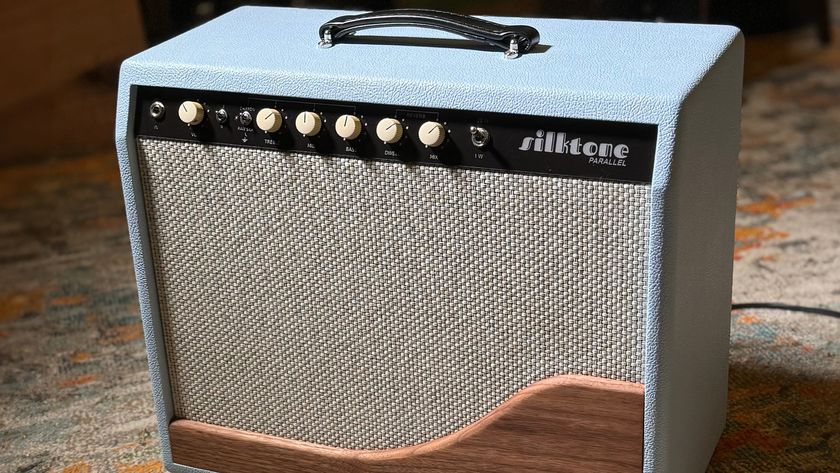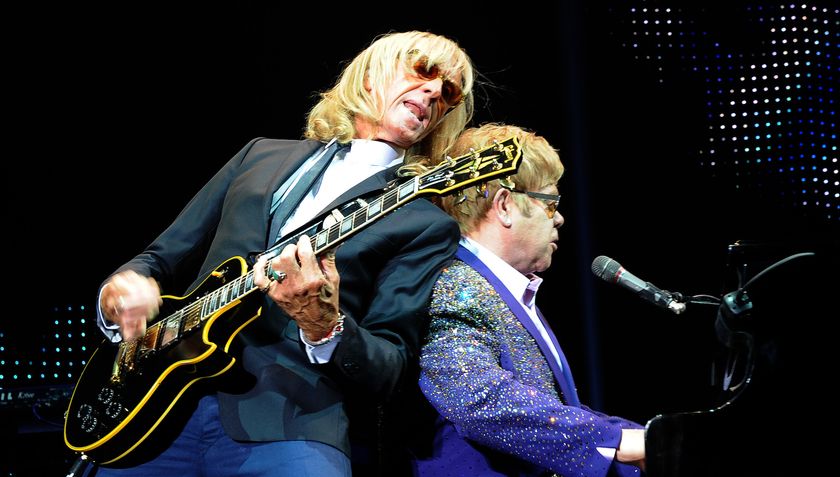The Beatles: guitar by guitar – a guide to the models that made music history
The Beatles revolutionised music and made the guitar the world's most popular instrument. On the 50th anniversary of their final album, we trace the models that made the magic…
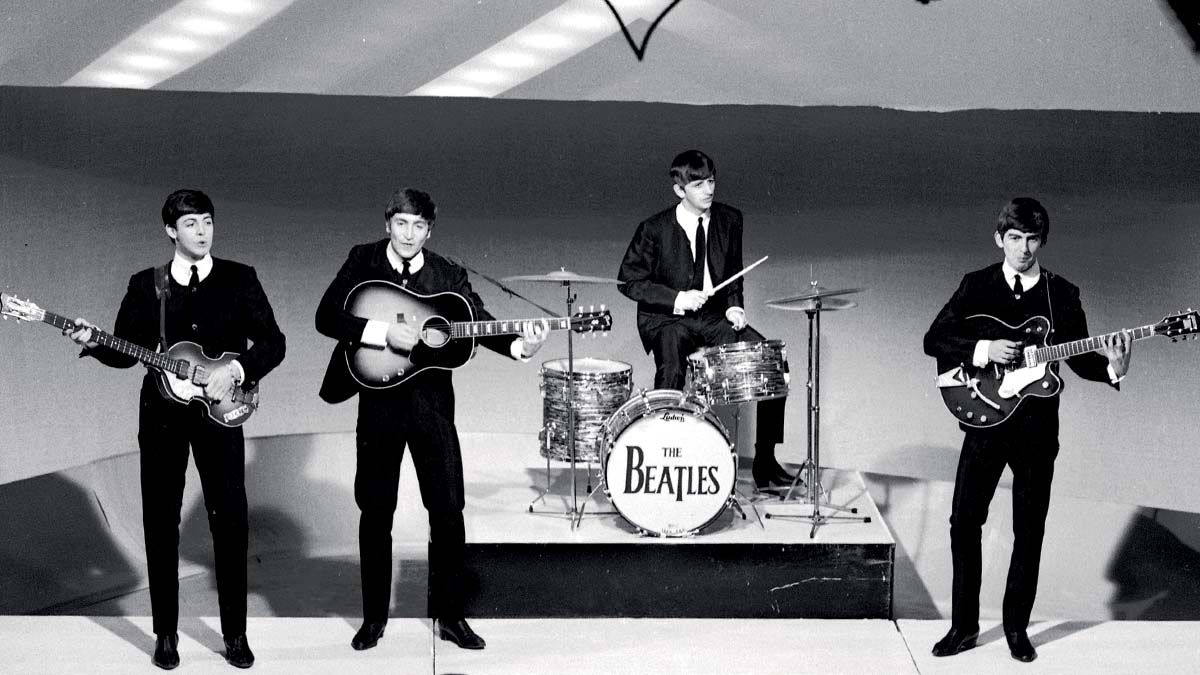
John Lennon wrote a typically oddball piece for Mersey Beat magazine in 1961 titled ‘Being A Short Diversion On The Dubious Origins Of Beatles’. He said that three boys called John, George and Paul got together. “When they were together,” he wrote, “they wondered what for after all, what for? So all of a sudden they grew guitars and fashioned a noise.”
In fact, the fledgling Beatles were like most young bands starting out. They had no money to buy good instruments and managed with anything they could get their hands on. John had a Gallotone Champion flat-top, then an electric Hofner Club 40. George Harrison moved from an Egmond/Rosetti acoustic to a Hofner President, then his own Club 40, followed by a Futurama.
Paul McCartney played a Zenith Model 17 acoustic, then a Rosetti Solid 7 electric. For their first gigs in Hamburg, Paul (still a guitarist) took the Solid 7, John his Club 40, George the Futurama, and Stu Sutcliffe a Hofner 500/5 bass. None of these were great guitars – those came later. And, fortunately, the Hamburg audience required nothing much more than a noise to drink to.
John Lennon was the first Beatle to get a real American guitar, at a time when a restriction on imports of US instruments to Britain had only just been lifted
George was later asked about his early guitar days. “I started to learn to play when I was 13 on an old Spanish model my dad picked up for 50 bob,” he explained. “It’s funny how little things can change your life. Don’t ask me why he chose a guitar instead of a mouth organ or something – they certainly weren’t popular at the time.”
John & Rickenbacker
John Lennon was the first Beatle to get a real American guitar, at a time when a restriction on imports of US instruments to Britain had only just been lifted. In 1960, during a working visit to Hamburg, he got a Rickenbacker 325 in Mapleglo (natural) finish to replace his Club 40.
He told an interviewer at the time that his semi-solid three‑pickup short-scale ’58 325 – which evidently had been on the shop wall for some time – was “the most beautiful guitar”. It had the cooker knobs that Rickenbacker fitted at the time and it had a Kauffman vibrato, neither apparently to John’s liking.
The knobs he replaced quickly with smaller Hofner types. The Kauffman he replaced with a better Bigsby unit. Later, he had the guitar refinished black. A gift from Rickenbacker provided a replacement for the road-weary original, a new Jetglo (black) 325 presented during The Beatles’ first American visit early in 1964. The new Rick arrived in time for the band’s second appearance on The Ed Sullivan Show.
Get The Pick Newsletter
All the latest guitar news, interviews, lessons, reviews, deals and more, direct to your inbox!
It remained his main guitar on stage and in the studio through 1964 and into 1965, and it’s the guitar most associated with John on stage with The Beatles. He had a couple of related models, too.
Rose-Morris, which for a while distributed Rickenbackers in the UK, gave John a 325-like 1996 in Fireglo (red sunburst) to use briefly in late ’64 when he damaged his 325. Rickenbacker also gave him a one-off 325-style Jetglo 12-string in ’64, but he didn’t use it much.
• Where Are They Now?
Yoko Ono owns the ’58 and ’64 325s and the ’64 325/12. John gave the stopgap 1996 to Ringo, who auctioned it in 2015 for $910,000.
When He Was Fab
“I bought a Futurama. This was the guitar which I played right through the Cavern and German Night Club days…”
George Harrison
George Harrison bought his Futurama from Hessy’s Music Centre in Liverpool in the late 1950s and used it for the next few years until it was retired and replaced with a Gretsch Duo Jet in 1961. The guitar was initially given to the magazine Beat Instrumental as a competition prize, but, surprisingly, when the winner was drawn, he didn’t play guitar and opted to take a cash alternative.
The guitar spent the next few decades in the care of Beat Instrumental’s editor Sean Mahoney and was put up for auction at Bonhams in June 2019 but didn’t make its reserve price. Seven Decades’ Phil Hylander subsequently negotiated directly with Mahoney’s family and bought the guitar.
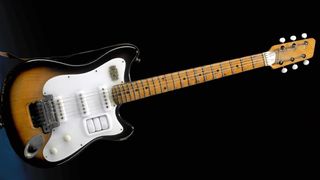
“If you look at pretty much any picture from that era, George is holding this guitar,” Phil tells us. “It was used on [one of] the very first Beatles recording[s], Cry For A Shadow, on the infamous Hamburg tapes. It’s stood up incredibly well, it was an incredibly well-made guitar. The manufacturers [Drevokov in Czechoslovakia] were classical instrument manufacturers and it’s quite over-engineered.”
Plans are afoot for the guitar to feature in a film detailing its recommissioning, culminating in it being played live. “In our minds, it would be at an amazing gig where Dhani Harrison plays it…,” says Phil.
For more information, see Seven Decades.
George & Gretsch
George Harrison’s opportunity to join John as the owner of a real American guitar came in 1961, when he heard about a ’57 Duo Jet that a merchant seaman had for sale in Liverpool.
George snapped up the guitar to replace his Futurama. The Jet had two DynaSonic single coils, hump-block markers and arrow-through-G knobs, and it remained his favoured stage and studio guitar into 1962.
George was a big Chet Atkins fan and soon he indulged his Gretsch passion some more, buying a new Gretsch Chet Atkins Country Gentleman model in London in 1963. It was a ’62 model in Walnut (dark brown) finish and had a double-cut thinline hollow body with trestle bracing and fake f-holes, a pair of Filter’Trons, and a Bigsby vibrato.
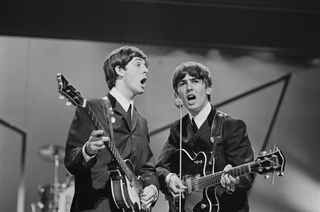
A few weeks later, George used it to record She Loves You, but later in ’63 he acquired a replacement Gent after that first one was damaged.
The main visual clue of the second Gent is its flip-up mute switches either side of the tailpiece, where the first had screw-down knobs. It’s possible the second Gent was refinished black, though maybe it just had a very dark version of the regular brown. Anyway, it was quickly George’s favourite and he used it regularly until it was destroyed in late ’65 when it fell from the band’s car and was run over by a truck.
He’d acquired yet another Gretsch Chet model over the 1963/’64 new year, a single-cut Tennessean with two single-coil HiLo’Trons, which he used in the studio and for live shows in ’64 and particularly into ’65.
• Where Are They Now?
Olivia Harrison owns the ’57 Duo Jet. George gave Brian O’Hara of The Fourmost his ’62 Gent, present whereabouts unknown, and the ’63 Gent perished in 1965. The Tennessean was stolen in 1969 and hasn’t been seen since.
A Pair of Gibson Jumbos
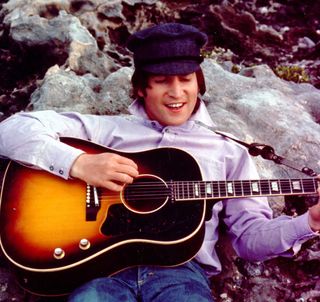
George and John bought a virtually identical pair of guitars in 1962, the source of some confusion later as to which instrument belonged to which Beatle.
They ordered a pair of Gibson J-160E electro flat-tops from the Rushworth’s music shop in Liverpool – which in turn had to make a special order, because this was not a model generally available in Britain through Gibson’s distributor, Selmer.
The two Beatles chose the J-160Es to fill a gap in their instrumental setup. It was essentially a traditional round-soundhole acoustic but with a pickup and controls built in.
They regularly used the pair of big Gibsons either unplugged as regular acoustic guitars for songwriting on the road and for studio work, or plugged in for an amplified approximation of an acoustic on stage or when recording. So similar were the guitars that inevitably they were swapped around.
Late in 1963, the J-160E John Lennon was playing was stolen during the band’s Christmas concert residency in London. In fact, it was the one billed originally to George – so George and John in effect continued to use John’s.
John picked up a new J-160E while on tour in the States later in 1964, and this one stayed with him for the rest of his life. He had it painted with a blue and lilac psychedelic pattern in 1967, stripped it to the wood the following year, and drew portraits of himself and Yoko on the front in 1969. George kept John’s original 160 for the rest of his life, too.
• Where Are They Now?
Yoko Ono owns John’s ’64 J-160E and Olivia Harrison owns what became George’s 160E. John’s long-lost ’62 model was sold at auction in 2015 for $2,410,000.
George & the Rick 12
The Beatles’ live TV performance on The Ed Sullivan Show on 9 February 1964 broke the band in the States in spectacular fashion. For George, though, the day before was just as important. Rickenbacker boss Francis Hall brought the band some new gear to check out. George ended up with a fabulous gift of a prototype Rick 360/12 (and John got that gleaming new-look version of his 325, too).
George once compared the Rick 12’s sound to an organ or electric piano, which makes sense when you hear some of the sounds he got from it on A Hard Day’s Night
George waited until the band returned home to use his new toy, and the studio debut of his chiming 360/12 can be heard on the lively take of You Can’t Do That, recorded on 25 February, his 21st birthday. He started to use the 12-string – described by Melody Maker as “the beat boys’ secret weapon” – all over live and studio Beatle performances.
During the band’s third US tour, in 1965, he received a 360/12 in Rickenbacker’s new rounded-body style. He began using it rather than his original, as on the session for If I Needed Someone for Rubber Soul, the last Beatles track with electric 12, and on stage into ’66.
George once compared the Rick 12’s sound to an organ or electric piano, which makes sense when you hear some of the sounds he got from it on A Hard Day’s Night, notably its most famous studio moment within the opening chord of the album’s title song. “That sound,” George said much later, “you just associate with those early 60s Beatle records. The Rickenbacker 12-string sound is a sound on its own.”
• Where Are They Now?
Olivia Harrison owns the original ’63 360/12, but the ’65 model was stolen and remains lost.
A Pair of Epiphone Thinlines
Early in 1965, John played some new recordings to a Melody Maker reporter at Abbey Road. Suddenly, he said, “Hey, listen! Hear that playing by Paul?” It was probably during playback of Ticket To Ride or Another Girl. “Paul’s been doing quite a bit of lead guitar work this week,” John explained. “I reckon he’s moving in.”
Not content with his bass work at the lower end of Beatle cuts, Paul was taking more interest in guitar playing – and remember, he’d started in the band as a guitarist.
At the end of 1964, Paul bought himself an Epiphone Casino, restrung and played “upside down” to accommodate his left-handed style. Gibson had owned Epiphone since the late 50s, and the new-for-1961 Casino model was based on Gibson’s hollowbody ES-330.
In ’68, Clapton gave a ’57 Les Paul to George who let Eric play it for the solo on ‘While My Guitar Gently Weeps’, making Eric the only non-Beatle to play a solo on a Beatles record
The year after Paul’s purchase, John and George each bought a Casino, too, and they used them on the sessions for Revolver, as did Paul. Paul’s ’62 model had the black knobs and Gibson-style headstock of the period, while John and George’s ’65 models had gold knobs and the later ‘flared’ Epi head.
George’s came with a Bigsby, John’s with the regular trapeze tailpiece. John and George played their Casinos during most of the band’s final live dates in 1966, including the very last Beatles concert at Candlestick Park in San Francisco that August.
Later, both guitarists had the sunburst finish stripped from their Casinos to reveal the natural wood. George said later he thought it improved the sound of his guitar.
• Where Are They Now?
Paul owns his ’62 Casino, Olivia Harrison owns George’s ’65 model, and Yoko Ono owns John’s ’65.
Rhythm Makers – The Beatle Basses
Stu Sutcliffe was the first bass player in The Beatles, using a ’59 Hofner 500/5, but he left the band in 1961, and soon Paul switched to bass. Paul bought his first bass guitar in Hamburg in 1961. It was a left-handed Hofner 500/1, a type known since as a Beatle Bass or, for its shape, as a violin bass.
That ’61 Hofner saw him through the band’s early days, but in 1963 he bought a replacement, using the lefty ’63 500/1 on stage and in the studio throughout the glory years of The Beatles. The pickups provide the main visual clues to tell the two Hofners apart: the pickups of the ’61 bass are close together at the neck, while the ’63 bass has the pickups spaced conventionally at the neck and bridge.
Paul was another beneficiary of Rickenbacker’s generosity, receiving a lefty 4001S bass from the company on a US tour in 1965, and he used it on many Beatle records.
Originally, it had a red Fireglo finish, but Paul gave it some colourful additions in 1967. Later, he stripped it back to natural wood and reshaped the top horn. Paul used another gift, a lefty Fender Jazz Bass, on some of the later Beatle sessions.
• Where Are They Now?
Paul owns the ’63 Hofner bass, the 4001S, and the Jazz Bass, but the ’61 Hofner was stolen in 1969, and Stu’s 500/5 is owned by the Hard Rock Cafe.
A Pair of Blue Strats
Rubber Soul had many Beatle fans wondering about the new sounds contained in its grooves. Take that concise solo in Nowhere Man, where two unison guitars give way to one solitary pinging harmonic. A new Beatle sound, for sure! The source? A pair of Fender Stratocasters freshly added to the band’s guitar store. George and John decided around the end of ’64 to get a Strat each.
The story goes that they sent out Beatles roadie Mal Evans to find them and he returned with two Strats in Fender’s pale Sonic Blue finish. They were often used in the studio, while John played his at least once at the band’s Christmas ’64 concerts. And during rehearsals in late ’65, John briefly used a Strat in black finish with matching headstock.
In 1967, George took some paint and nail varnish and transformed his Strat into a personalised psychedelic artwork
In 1967, The Beatles decided to paint a few of their instruments in psychedelia-inspired colour schemes. Paul decorated his Rickenbacker bass. John had his J-160E painted blue and lilac and sprayed the back of his Casino silver.
George, meanwhile, took some paint and nail varnish and transformed his Strat into a personalised psychedelic artwork. That summer, his newly daubed Fender was just about visible – in glorious black-and-white – as the band performed All You Need Is Love for the Our World global satellite broadcast.
His psych Strat was more colourfully displayed in the I Am The Walrus sequence from the band’s TV film shown that Christmas, Magical Mystery Tour, with its central character of a dayglo-painted charabanc. Later, maybe in a fit of post-trip good taste, Paul and John had the paint stripped off the coloured guitars, down to the natural wood, but George’s Strat stayed steadfastly psychedelic.
• Where Are They Now?
John’s 60s Strat hasn’t been seen since, but Olivia Harrison owns George’s ’61 ‘Rocky’ Strat.
Forever Fab – Other Beatle Guitars
The Beatles acquired a number of other guitars beyond their main instruments, and we’ll consider a selection here. Paul got a Fender Esquire in the first few months of 1967, which he used briefly in the studio, notably on his solo on Good Morning, Good Morning from Sgt Pepper’s.
He’d also picked up an Epiphone Texan flat-top in ’64, mainly to use live for Yesterday, but also as a songwriting tool – and he landed another nice acoustic, a Martin D-28, in ’68.
A few guitars were used by the band collectively, including a Framus Hootenanny 5/024 flat-top 12-string, picked up around the start of ’65, and a Fender VI, given to the band by Fender along with several other bits of gear in 1968.
John got a Martin D-28 at the same time Paul got his, and he came by a Gretsch 6120 in 1965, which he was photographed using briefly at Abbey Road. In 1969, he played a Hofner Hawaiian Standard lap-steel for the slide part on For You Blue.
George borrowed a Gretsch Jet Fire Bird early in ’63 while his Duo Jet was being repaired, and that same year bought a Rickenbacker 425 in the States while visiting his sister and used it for a few performances.
Another temporary replacement in ’63 for a guitar undergoing repairs was a Maton MS500. George also acquired a couple of useful acoustics: a Ramírez Guitarra de Estudio classical that he used in ’64 for And I Love Her, and a Gibson J-200 that he bought in America in ’68.
• Where Are They Now?
Paul owns his Texan and his D-28. The 6120 John used briefly was sold privately in 2015 for $530,000. The 425 George used briefly was sold at auction in 2014 for $657,000, and the Maton he used was sold at auction in 2018 for £280,000. George gave his J-200 to Bob Dylan (as seen on the cover of Nashville Skyline). The Esquire, Hawaiian Standard, Hootenanny, Jet Fire Bird, Ramírez, VI, and John’s D-28 have since gone AWOL.
George the Guitar Fan
![Fender’s Custom Shop launched a reissue of George’s Rosewood Tele in 2017. [See bottom for our demo] Rumours swirl about plans for a cheaper version – fingers crossed!](https://cdn.mos.cms.futurecdn.net/eR8cZXJip5dx2UkyoUR2h-320-80.jpg)
George got his first Gibson with humbuckers in 1965, a luscious ES-345 that he used while miming in promo videos for Day Tripper, Help!, I Feel Fine, Ticket To Ride, and We Can Work It Out. He played it that December on what turned out to be the band’s final British tour.
The following year, George got an SG Standard, used at Abbey Road when sessions began in April 1966 for Revolver and played at an NME concert in London in May, which marked The Beatles’ final British concert appearance. George also used his SG in more videos to promote the Paperback Writer/Rain single in ’66 and Lady Madonna in ’68.
In 1967, George took some paint and nail varnish and transformed his Strat into a personalised psychedelic artwork
In 1968, Eric Clapton gave a Les Paul to George. It was a ’57 Goldtop refinished in Cherry, and George named it Lucy and used it on several White Album and Abbey Road cuts [and above in the video for Revolution]. He let Eric play it once more for the solo on While My Guitar Gently Weeps, making Eric the only non-Beatle to play a guitar solo on a Beatles record.
George’s final new Beatle guitar was a prototype Fender Rosewood Telecaster, made by Roger Rossmeisl, a gift from Fender that arrived at the band’s London Apple HQ in late ’68. George played it for the Apple rooftop concert on 30 January 1969 – The Beatles’ last ever public performance, seen in their Let It Be film.
• Where Are They Now?
George gave his SG to Badfinger’s Pete Ham, whose brother sold it at auction in 2004 for $567,500, and his Rosewood Tele to Delaney Bramlett, who auctioned it in 2003 for $434,750. Both are owned now by Olivia Harrison, who also owns George’s Les Paul. The 345’s whereabouts are unknown.
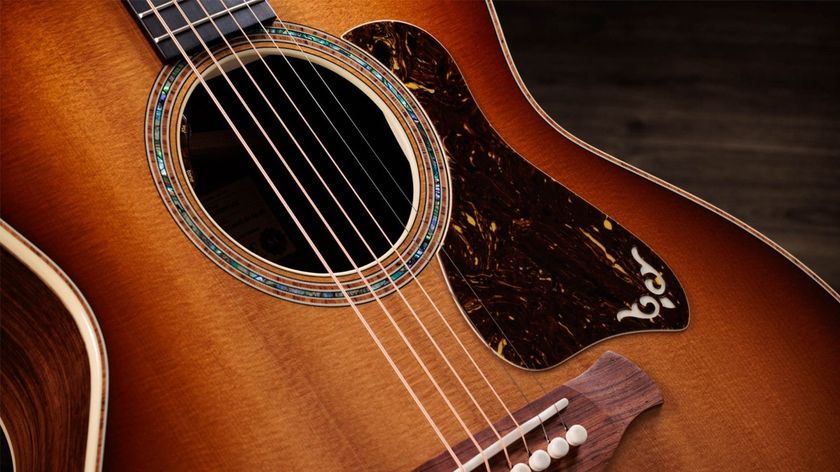
“An investment-grade, pro-quality guitar that will provide decades of playing enjoyment before it becomes a treasured family heirloom”: Taylor Gold Label 814e SB review
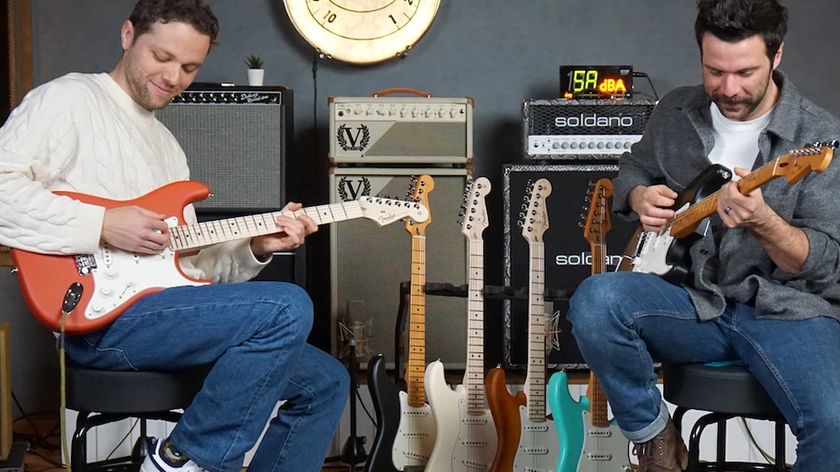
“Satin Stratocaster dreams”: Fender and Thomann have produced two new exclusive Stratocaster lines – and their prices rival existing US and Mexico-made models






